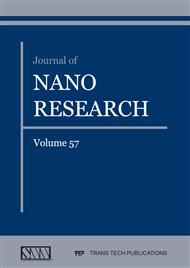[1]
Upasana, Rakhi Narang, Monoj Saxena, Mirdula Gupta, Modeling and TCAD Assessment for Gate Material and Gate Dielectric Engineered TFET Architectures: Circuit-Level Investigation for Digital Applications,, IEEE Trans. On Electron Devices, vol. 62, no. 10, pp.3348-3356, (2015).
DOI: 10.1109/ted.2015.2462743
Google Scholar
[2]
Vishwa Prabhat, Aloke K. Dutta, Analytical Surface Potential and Drain Current Models of Dual-Metal-Gate Double-Gate Tunnel-FETs,, IEEE Trans. on Electron Devices, vol. 63, no. 5, pp.2190-2196, (2016).
DOI: 10.1109/ted.2016.2541181
Google Scholar
[3]
P. Long et al., A tunnel FET design for high-current 120 mV operation,, IEDM Tech. Dig., p.30.2.1-30.2.4, Dec. (2016).
Google Scholar
[4]
B. R. Raad, K. Nigam, D. Sharma, P.N. Kondekar, Performance investigation of bandgap gate material work function and gate dielectric engineered TFET with device reliability improvement,, Superlattices and Microstruct., vol. 94, pp.138-146, (2016).
DOI: 10.1016/j.spmi.2016.04.016
Google Scholar
[5]
S. L. Noor, S. Safa, M. Z. R. Khan, Dual-material double-gate tunnel FET: gate threshold voltage modeling and extraction,, Journal of Computational Electronics, vol. 15, no. 3, pp.763-769, (2016).
DOI: 10.1007/s10825-016-0816-3
Google Scholar
[6]
S. L. Noor, S. Safa, M. Z. R. Khan, A silicon based dual material double gate tunnel field effect transistor with optimized performance,, International Journal of Numerical Modelling: Electronic Networks Devices and Fields, (2017).
DOI: 10.1002/jnm.2220
Google Scholar
[7]
S. Gupta, K. Nigam, S. Pandey, D. Sharma, P. N. Kondekar, Effect of interface trap charges on performance variation of heterogeneous gate dielectric junctionless-TFET,, IEEE Trans. Electron Devices, vol. 64, no. 11, pp.4731-4737, Nov. (2017).
DOI: 10.1109/ted.2017.2754297
Google Scholar
[8]
M. Gholizadeh and S. E. Hosseini, A 2-D analytical model for double gate tunnel FETs,, IEEE Trans. Electron Devices, vol. 61, no. 5, p.1494–1500, May (2014).
DOI: 10.1109/ted.2014.2313037
Google Scholar
[9]
Bagga N, Sarkar SK. An analytical model for tunnel barrier modulation in triple metal double gate TFET. IEEE Trans Electron Devices 62:2136–2142, (2015).
DOI: 10.1109/ted.2015.2434276
Google Scholar
[10]
A Ravindran, A George, CS Praveen, Gate All Around Nanowire TFET with High ON/OFF Current Ratio, Materials today: proceeding, Vol.4, No.9, Pp.10637-10642, (2017).
DOI: 10.1016/j.matpr.2017.06.434
Google Scholar
[11]
Bahniman Ghosh, Mohammad Waseem Akram, Junctionless Tunnel Field Effect Transistor,, IEEE electron device letters, Vol.34, No.5, 584 - 586, April (2013).
DOI: 10.1109/led.2013.2253752
Google Scholar
[12]
T.S. Arun Samuel and S.Komalavalli, Analytical Modelling and Simulation of Triple Material Quadruple Gate Tunnel Field Effect Transistors,, Journal of nano research, Vol. 54, pp.146-157, (2018).
DOI: 10.4028/www.scientific.net/jnanor.54.146
Google Scholar
[13]
P. Vanitha, T.S. Arun Samuel, D.Nirmal, A New 2 D Mathematical Modeling of Surrounding Gate Triple Material Tunnel FET using halo Engineering for Enhanced Drain Current,, AEU-International Journal of Electronics and Communication, 2018 (published online).
DOI: 10.1016/j.aeue.2018.11.013
Google Scholar
[14]
T.S. Arun Samuel and M.Karthigai Pandian, Comparative Performance Analysis of Multi Gate Tunnel Field Effect Transistors,, Journal of Nano Research, Vol. 41, pp.1-8, (2016).
DOI: 10.4028/www.scientific.net/jnanor.41.1
Google Scholar
[15]
B.Padmanaban, R.Ramesh, D.Nirmal and S.Sathiyamoorthy. Numerical modeling of triple material gate stack gate all-around (TMGSGAA) MOSFET considering quantum mechanical effects,, Super lattices Microstruct. Vol.82, p.40–54, (2015).
DOI: 10.1016/j.spmi.2015.01.021
Google Scholar
[16]
E. O. Kane, Theory of tunnelling,, Journal of Applied Phys, vol. 32 No. 1, p.83–91, (1961).
Google Scholar
[17]
T.S. Arun Samuel, N.B. Balamurugana, S. Bhuvaneswari, et al. Analytical modelling and simulation of single-gate SOI TFET for low-power applications. International Journal of Electronics, 101(6), 779–788,(2014).
DOI: 10.1080/00207217.2013.796544
Google Scholar
[18]
ATLAS: Device simulator software, SILVACO Int., Santa Clara, CA, USA(2013).
Google Scholar
[19]
M. Noguchi et al., High Ion/Ioff and low subthreshold slope planartype InGaAs tunnel FETs with Zn-diffused source junctions,, in Proc.IEDM Tech. Dig., 2013, p.28.1.1–28.1.4.
Google Scholar
[20]
G. Dewey et al., Fabrication, characterization, and physics of III-V heterojunction tunneling field effect transistors (H-TFET) for steep sub-threshold swing,, in Proc. IEDM Tech. Dig., Washington, DC,USA, 2011, p.33.6.1–33.6.4.
DOI: 10.1109/iedm.2011.6131666
Google Scholar
[21]
Wei Cao, Deblina Sarkar, Yasin Khatami, Jiahao Kang, and Kaustav Banerjeea, Subthreshold-swing physics of tunnel field-effect transistors,, American Institute of Physics, 4, 067141 (2014).
DOI: 10.1063/1.4881979
Google Scholar
[22]
Fahad H. & Hussain M. High-Performance Silicon Nanotube Tunneling FET for Ultralow-Power Logic Applications. IEEE Trans. Electron Devices. 60, 1034–1039 (2013).
DOI: 10.1109/ted.2013.2243151
Google Scholar
[23]
L. Knoll, Q. T. Zhao, A. Nichau, S. Richter, G. V. Luong, S. Trellenkamp, A. Schäfer, L. Selmi, Demonstration of Improved Transient Response of Inverters with Steep Slope Strained Si NW TFETs by Reduction of TAT with Pulsed IV and NW Scaling. Paper presented at IEEE Int. Electron Devices Meet.,Washignton, DC, USA. Washignton: IEEE, (2013).
DOI: 10.1109/iedm.2013.6724560
Google Scholar
[24]
Priya, G. L., & Balamurugan, N. B. (2019). New dual material double gate junctionless tunnel FET: Subthreshold modeling and simulation. AEU - International Journal of Electronics and Communications, 99, 130–138. (published online).
DOI: 10.1016/j.aeue.2018.11.037
Google Scholar


